June is the LGBT+/GSRM 🏳️🌈 Pride month!
2022/06/28 (Tuesday) - Elisa Claire Alemán Carreón, PhD
Did you know June is the LGBT+ Pride month? To me it is general knowledge, but to many in the workplace, it might not be. In today’s entry I’ll speak about the basics of queer vocabulary, why it’s an important month for us, and what companies and academic places can do to make their workplace a better place for everyone.
Of course, many people know since it has become a common theme in the news, but not all countries have this, and living in Japan, it is only talked about within queer circles and still carries a lot of stigma.
First let me start with the title. Lot’s of people know about LGBT+, however, not everyone knows what it means, or how many letters we should use, etc.
Below I list the ones I used up to now:
- LGBT+: Lesbian, Gay, Bisexual, Transgender, and other queer identities and sexual minorities
- GSRM: Gender, Sexual and Romantic Minorities. It’s close to the Japanese sekumai which means sexual minorities although it’s less specific.
- queer: An umbrella term encompassing all gender, sexual and romantic minorities, and sometimes used in defiance to being classified as one or the other for either case.
It’s important to add the + in LGBT+ because lots of identities aren’t represented in the abbreviations we used before. Some people used LGBTQ, LGBTQI, even as far as LGBTQIA2s… but none of them really span the whole spectrum of queerness, and someone gets left behind at some point. Which is why the + includes everyone under the name that everyone is familiar with.
However, that gives more representation to some than others, so the acronym GSRM got made, which includes all the different representations without putting anyone first… but it is also very little known by people so sometimes it’s not recognizable. When we want to make our point across, it’s important that everybody knows what we mean, so not many people use it.
Now, even before I finish writing my post I want to make sure: if anyone wants to ask questions, if anyone feels like they don’t understand, feel free to ask me questions through my contact info.
Table of Contents
- Basic knowledge:
- Relax, it’s not an exam
- Why is June the Pride Month? Stonewall Riots
- What does this have to do with workplace environment?
- Problems in Society
- Charities and Organizations
- What can a company or school do?
- Extra facts about Transgender people
- References
Basic knowledge:
The Pride Flag 🏳️🌈
The pride flag is representing all of the queer community, the rainbow being a symbol for it since 1978. However, in the past it was used as specifically the homosexual flag as opposed to other identities with their own flags. There is already a separate Lesbian flag, so sometimes it’s perceived as only the gay men flag. Recently however, there has been proposals of a flag only for men who are attracted to men, so that the Rainbow flag can stay as a representation of all queer people.
The S in GSRM: Sexual orientation
First let’s define sexual orientation. There are different types of attraction that we experience, such as sexual, romantic, platonic, aesthetic, etc. Sexual orientation is specifically about which people one is sexually attracted and how that relates to one’s own gender. More simply said, it’s who you are attracted to. It’s important to make a distinction here because there are many combinations depending on which type of attraction a person experiences.
Remember:
- You can like one gender
- You can like two
- You can like more
- You can like none
And this is all ok.

Heterosexuality
Heterosexuality is when men are attracted to women, or when women are attracted to men. It is usually seen as the default, but it is only one of the many sexualities there are. LGBT+ and queer pride doesn’t include this identity as part of the community because of this, but I mention it here to explain that we should use this terminology instead of words like “normal”, since this implies that LGBT+ people aren’t normal.
In addition, it’s entirely possible to be queer and straight at the same time. For example, there’s straight people with queer gender identities, or part of a romantic minority that makes them queer.
Homosexuality
The L and the G in LGBT+, Lesbian and Gay are terms for when someone are sexually attracted to people of the same gender. Gay is predominantly used to mean gay men, but some women also use the word gay to describe themselves.
Gay men
As I mentioned before, a flag specifically for gay men has been created recently so that the rainbow flag can encompass everyone.
Lesbian
This is the word we use when women are attracted to women. Some people also use this flag and word to mean “Non-men who are attracted to other people that aren’t men”. Depending on how people express their gender, they might or not use this label for them. It really depends on who you ask, and people use these flags differently.
Bisexuality
Bisexual is the word used for people who are attracted to two or more genders. I say two or more because in reality people can be attracted to different genders in the spectrum of identities that people can have. Sometimes Bisexuality might encompass all people, but with different preferences or tastes for each gender, or perhaps a tendency to like one gender more often than the other. It really is up to the person to define themselves and think about who they are attracted to. Some people actually write it as Bi+ since it includes more than two.
Pansexuality
Pansexuality is the word used to describe people who are attracted to people, regardless of their gender. It is said that the difference with Bisexuality is that it is not conditional, and that pansexual people might not even think of the gender of people before considering them attractive. However, this distinction is personal, and of course, people can have preferences and tastes about who they like. In the end, it’s up to the person to find the identity that best suits them and feels right.
Asexuality
Asexuality is a sexual orientation in which people don’t have any sexual attraction for any genders. It is also an umbrella term including Demisexuality or Gray-Asexual people, who experience some attraction, but it is rare or in very specific conditions, such that they relate to the Asexuality umbrella in some way.
* The opposite of Asexuality, experiencing sexual attraction is called Allosexuality.
We will talk about these identities more in The R in GSRM: Romantic orientation.
- Demisexual flag:
The R in GSRM: Romantic orientation
This part doesn’t have as many specific flags as the rest, but it deserves explanation.
As I mentioned in the beginning, there are several types of attraction. One of these is the romantic attraction, which is less about sexual desire and more about who one loves or wants to spend romantic time with.
Most of the time, people have the same sexual and romantic orientations. That is, if someone says “I like girls”, they might mean they like them sexually and also romantically fall in love with them. But in reality, these two can be different.

For example:
- An asexual person could not like any genders sexually but they could fall in love with people of a specific gender, or of any gender, if they are so inclined.
- Another example is someone who likes the opposite sex sexually (Heterosexual), but that romantically they only fall in love with the same sex.
There are many examples:
- Heteroromantic, likes the opposite gender romantically
- Homoromantic, likes the same gender romantically
- Biromantic, likes both or other genders romantically
- Panromantic, likes people romantically regardless of their gender
- Aromantic, doesn’t like any people romantically.
- Demiromantic, only likes people romantically rarely, or after a long time.
Aromantic people have their own flag too:
And so do Demiromantic people:
The G in GSRM: Gender identity
Gender identity is unrelated to who you are attracted to, and instead it’s about who you are. Gender identity is about what gender you feel like inside and want to live like. One can be cisgender, which means that one’s identity matches what one was assigned at birth, or transgender, which is when your identity doesn’t match the one assigned to you at birth.
Now, we also have to make a distinction about sex and gender.
- Sex: It is defined as the biological differences in the anatomical sense, primary and secondary sex characteristics, and reproductive organs.
- Gender: It is the psychological and social aspect of sex. It is an internal awareness of one’s identity regarding sex. It also encompasses sex-based social structures and assigned or taken roles.
Now! Neither of these are binary! [1,2,3] People are really diverse, and that is both in identity and biology. You can see in this simplified graph just how varied we are.
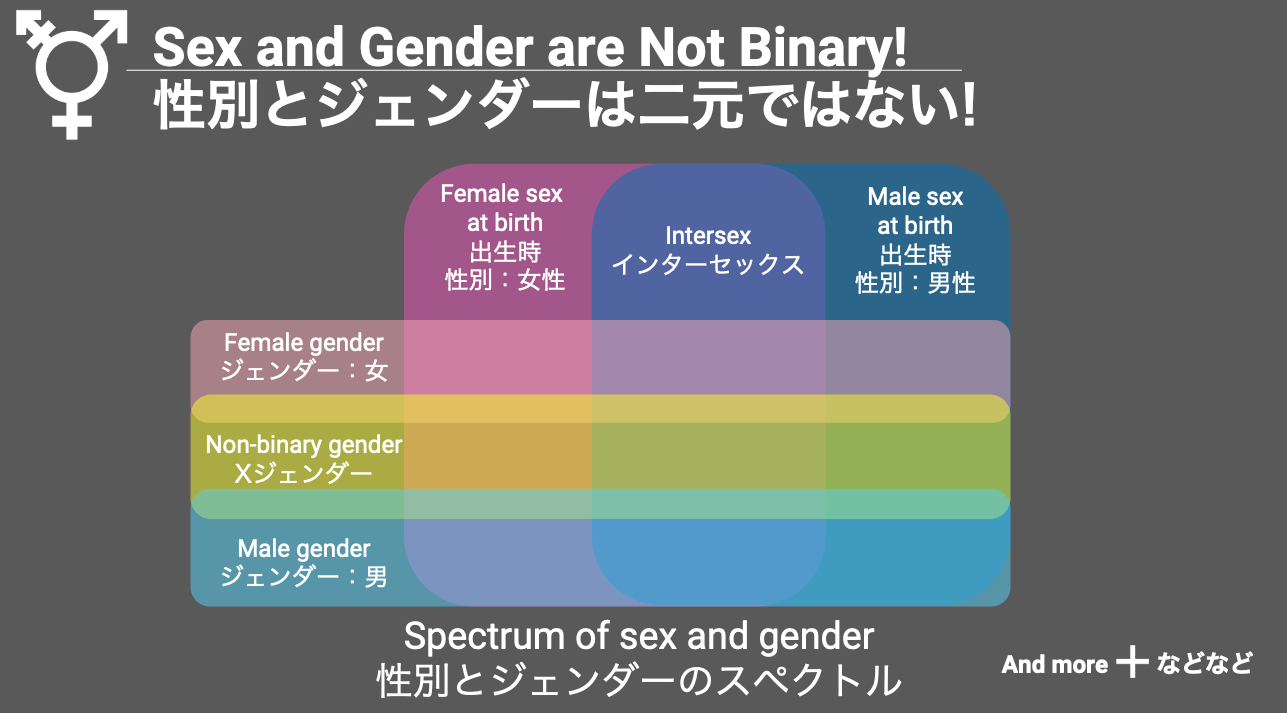
They’re also not fully independent from each other! For example, psychological gender might be related to biological hormones and neurological structure and neuro-chemicals that are hard to separate from sexual characteristics.
Remember: Gender identity is about what gender you feel like inside and want to live like.
- You can be a woman
- You can be a man
- You can be in between
- You can be none
- You can be both

With that in mind, let’s see the vocabulary for this:
Transgender
Transgender is an umbrella term, which means there can be other identities that belong to this category, and still be different from other people in the transgender community.
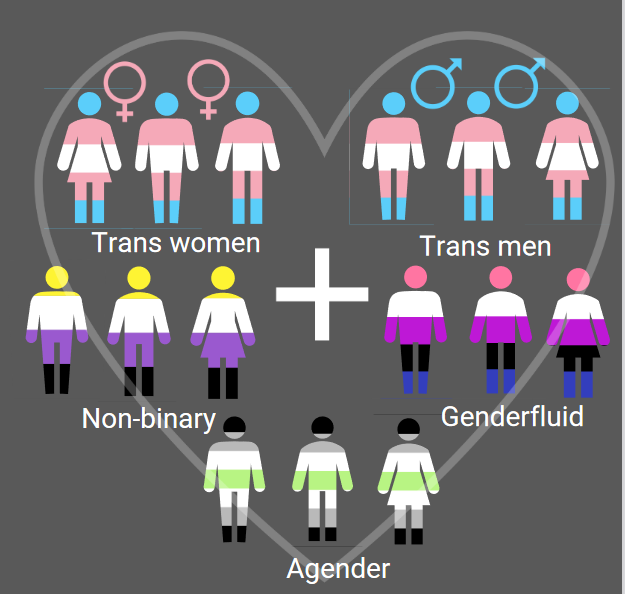
Since transgender people have the neurological structure and chemicals, and depending on treatment, hormones as well, it can’t be said that they have one sex and the opposite gender. In reality it is much more complex than that and it is an invalidating phrase that we should avoid repeating.

- Trans women were assigned male at birth, but Trans women are women
- Trans men were assigned female at birth, but Trans men are men
Non-binary
Non-binary people are transgender people who identify neither as a man or a woman, but something in between or something completely different. In Japan it’s sometimes known as X-Gender.
Agender
Agender people don’t identify with any gender whatsoever, not even the non-binary ones. In Japan, I believe I’ve seen it described as Musei.
Genderfluid
Genderfluid people move between identities or expressions. They identify as both, or one at a time.
Gender transition
Many trans people seek a gender transition to live as the gender they truly are, but not everyone can. Someone can be trans and do all, some, or none of these steps:

- Social transition
- Gender affirming appearance
- Hormone Replacement Therapy
- Legal Procedures
- Gender affirming surgeries
Gender expression
Gender identity and expression are different! Your identity is yours to decide regardless of what clothes you wear, what makeup you wear, etc. Your appearance doesn’t define you, you inherently will fit any appearance that you choose, because You are You, no matter what. Of course people can choose an appearance that affirms their identity and makes them happy, but this is secondary to their identity.
Pronouns and Names
Regardless of gender, people will sometimes choose a new name or pronouns that fit them better.
Out of respect, it’s important to use the correct pronouns for everybody, as well as their chosen name. It’s also important not to dig around and try to learn people’s past names, since it’s disrespectful and assumes that their identity isn’t valid. It’s only necessary to know for legal documents if the chosen name isn’t legal yet. It’s also important not to spread this information if you learn it through these means.
Now, regarding pronouns, these are the most common:
- Women: she/her
- Men: he/him
- Non-binary: they/them
However, everyone can use different pronouns if they so choose and so one should ask to be sure. Lately it’s become more and more widespread to introduce oneself with pronouns written on a screen name, on presentation cards, on name tags, etc.
Example:
Elisa Alemán (she/her)
However, I haven’t seen this be applied in Japan and the translation would be awkward.
The S in GSRM: Sexual Minorities: Intersex people
Now, we spoke before about the S in Gender, Sexual and Romantic Minorities. Well, sexual orientation is not the only sexual minority. In fact, we’ve been talking about types of attraction and gender identity, while there are minorities based on their biology.
I am of course talking about Intersex people.
Intersex people are people born with variations in chromosomes, gonads, sex hormones or genitals that do not fit the typical definitions for male or female bodies.
A person can be born intersex for many reasons:
-
such as having different genetic makeup
(XXY, XXX, 0X, XYY, XXYY) -
having an XY or XX genotype but
having sexual characteristics not matching that genotype -
hormone imbalances
-
hormonal insensitivity
(for example, XY females where androgens can’t be absorbed by the body, so the development was female, this usually goes unnoticed until a genome test is taken) -
gonadal or genital differences at birth
In reality, not all intersex people are detected at birth, and many go through life without ever knowing they were intersex until testing is done for other unrelated reasons, so we have no idea of knowing how many there are in the total population, although it’s estimated that around 1.7%, which is about the same as people with red hair.
Are intersex people trans?
They might be! It all depends on each person and how they identify. Some intersex people transition to a gender they identify with, while others don’t. Some identify fully as their assigned intersex identity at birth, making them cisgender.
Most of the time you will not know if someone is intersex but be mindful and respectful of not assuming anything of anyone.
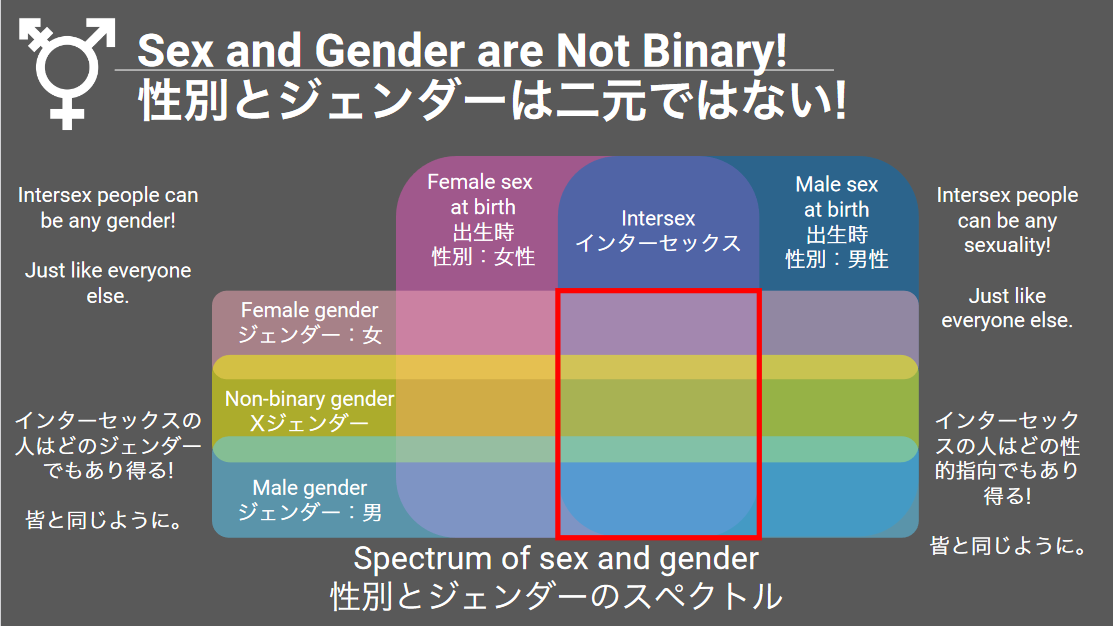
From birth, intersex people face injustice. Historically and to this day, many doctors will perform genital surgery on babies without consent to try to make them conform to a single gender that the doctors subjectively choose.
This is, of course, a human rights violation on par with genital mutilation.
Relax, it’s not an exam
Did everyone learn anything new? I know I wrote so many things, but I wanted to keep all the information in one place so that people can refer to it in the future.
It’s not important to remember all the flags, but to live in harmony and recognize that there’s many kinds of people, but that we are all humans. Let’s all walk into this world full of diversity together!
There are many combinations that can happen with gender identity, biological sex, sexual orientation and romantic orientation, and I really wanted to show you how diverse people can be.
If you have any questions beyond this please feel free to ask.
Why is June the Pride Month? Stonewall Riots
So, let’s talk about why June is the Pride month. In June 28th, 1969, there was something called the Stonewall riots, and that’s why Pride is done on June.
At that time, there was a very strong anti-gay climate in USA. LGBT+ people would be discriminated, banned from shops, and so on. Actually they had no place to go but illegal bars owned by the mafia, which welcomed the people that had nowhere else to go. A bar called Stonewall Inn owned by the mafia was one of those places, and LGBT+ people would gather there. But there were many raids and arrests by police to those places. Innocent LGBT+ people would get crushed on the ground and arrested or killed for no other reason than being LGBT+. So there was a reaction.
To make things simple, the riots went on and then they ended, but as a result, at last were LGBT+ rights starting to appear.
So what I want everyone to reflect this month is how our human rights have always come from people’s deaths and sacrifice.
✊🏾
What does this have to do with workplace environment?
All this might seem like something that has no relation to the workplace or academic settings, but indeed, people who live within these minorities have no way of separating this part of themselves in a society that expects assimilation with the status quo. Depending on where we live, there’s definitely rights that we don’t have compared to other people.
I want to talk specifically about Japan. In Japan, not only is there not equal marriage yet, but it’s not in any way legally defined that queer people can’t be discriminated. This means that, completely legally, people can lose their jobs, be denied housing, and therefore have a very hard time living here in Japan. The pressure to stay hidden therefore is there for many… and sometimes it is too much for people.
Since we don’t have any rights to defend ourselves, it’s in the responsibility of all of us to make changes
There’s also the topic of SDGs, which are the goals set by the UN that many companies are also undertaking.
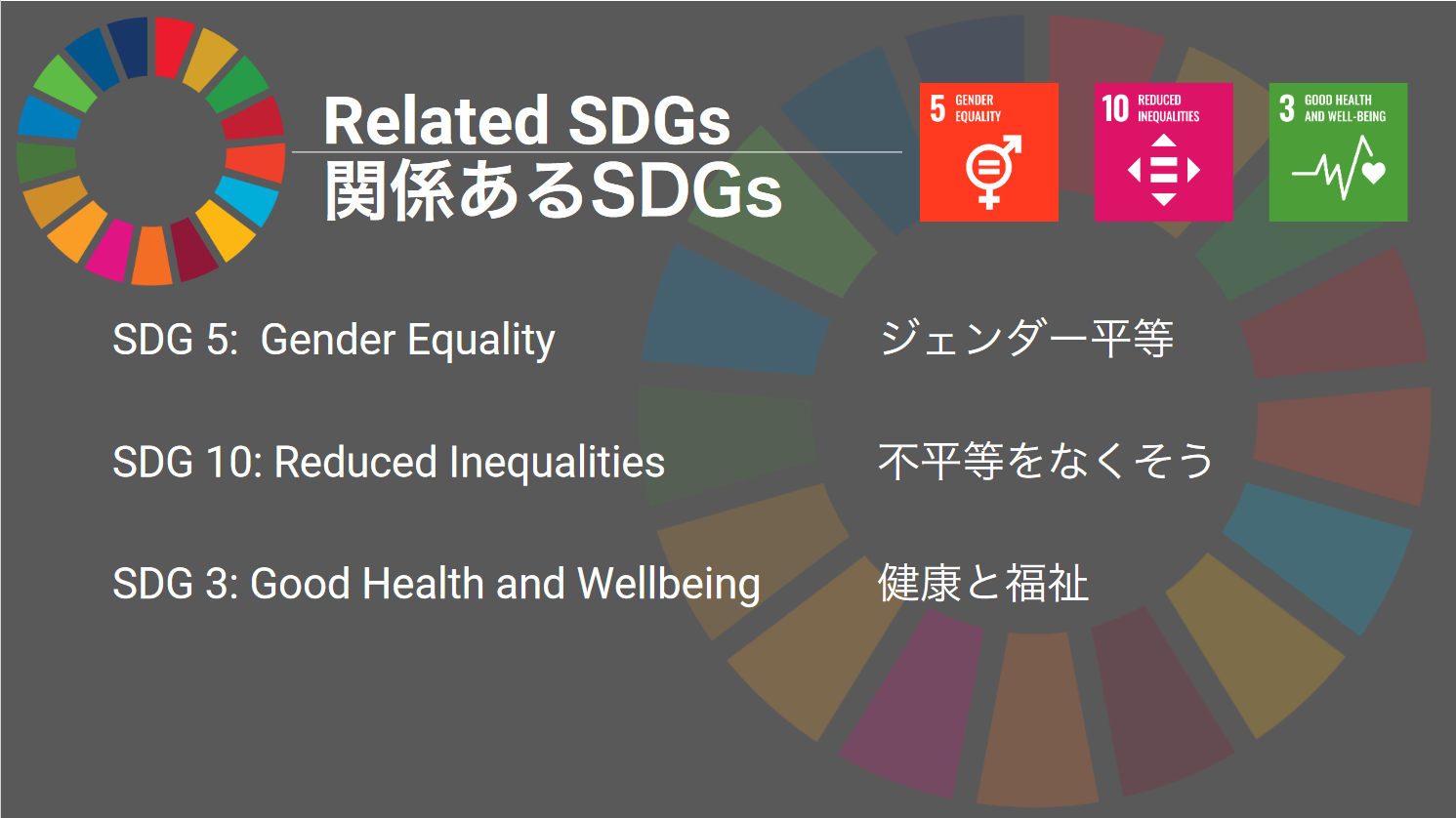
-
SDG 5: Gender Equality: All gender and sex discrimination should disappear for this goal to be true. This includes discrimination and violence against women. However, it also includes any people that don’t and can’t conform to gender norms and face discrimination for it.
-
SDG 10: Reduced Inequalities: To remove both societal and institutional inequalities, we need to make sure that discriminatory policies and laws are replaced with ones that progress and achieve more equality. Both people and laws need to both improve, or the results are reduced.
-
SDG 3: Good Health and Wellbeing: Discrimination can infringe upon liberties, normal development in society, and mental and physical health. Sadly, in many cases, it can lead to death by violence or suicide.
Problems in Society
In Japan, LGBT+ people are estimated to be around 8% of the population in Japan [4] and similar numbers across the world [5]. However, since many people hide it, it could be more.
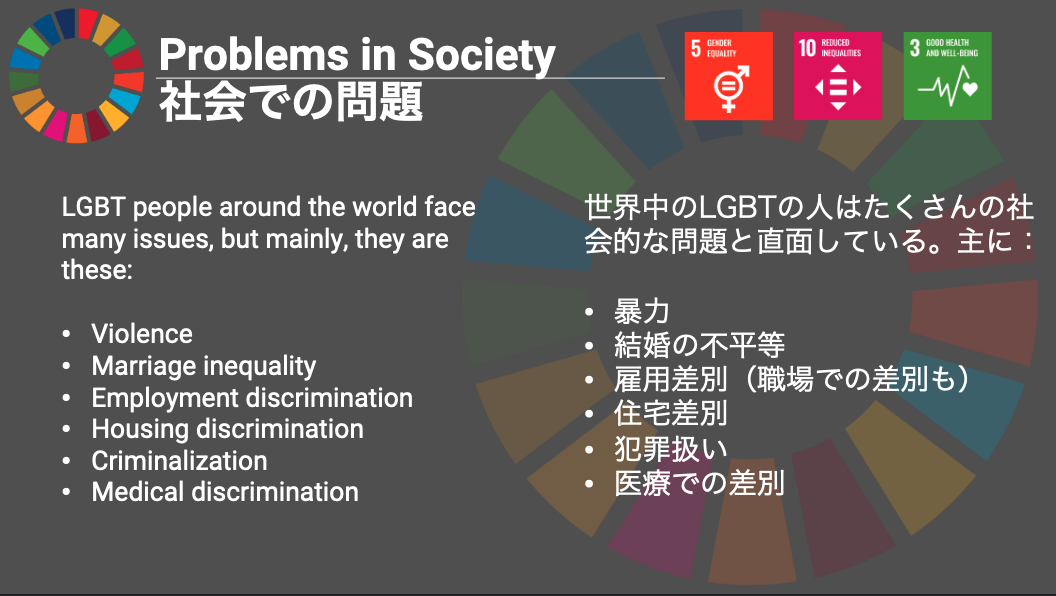
LGBT+ people around the world face many issues, but mainly these:
- Violence
- Marriage inequality
- Employment discrimination
- Housing discrimination
- Criminalization
- Medical discrimination
Now, as I mentioned before, in Japan, not only is there not equal marriage yet, but it’s not in any way legally defined that queer people can’t be discriminated. This means that queer people can easily lose their jobs, become homeless, and face violence.
Violence against LGBT+ people
LGBT+ people face violence and hate crimes across the world [6].
Many die horribly maimed or disfigured. This has been done by general citizens as well as police and military.
Japan is not free of this, since there’s also cases of homophobia and transphobia led murders, as well as abuse and discrimination by officials. [7]
Marriage inequality
In many countries, Japan included, it is still not legal to marry people of the same sex.
This means:
- No legal protections after a partner dies
- No shared assets
- No shared health insurance
- No visa / passport benefits
- No legal co-parenting
- No hospital visitations
- No tax deductions
In hospitals, perhaps a person is denied visitation because of not being technically family of their loved one. Aside from that, if a partner dies they can’t leave inheritance to non-family members.
Also, in most companies, if one person is married, the partner usually gets health insurance. There’s also the national reduced taxes for the increase in family members that isn’t available to people who aren’t legally married.
Employment and housing discrimination
In many countries, Japan included, LGBT+ people aren’t legally protected against employment or housing discrimination, which means that they can be:
- denied a job
- fired without reason
- denied housing
- evicted without reason
And there is no legal repercussion for the denying party. This leads to homelessness in many cases, specially for trans people.
There’s a lot of homeless queer people, or people who lost everything once their families became estranged from rejection. Depending on the age that this estrangement happens, sometimes that means minors would need approval signatures from parents when they refuse to help for, say, housing.
Medical discrimination
Medical treatment is often denied to LGBT+ people across the world, often leading to death.
In less extreme but still discriminatory cases, trans people are ridiculed or misgendered by doctors. A lack of transgender knowledge also leads to mistreatment or misdiagnoses (for example, blaming hormones for everything).
Trans people are also denied medical or legal transition without achieving prerequisites or staying in a long wait list in many countries, including Japan.
Legal discrimination
In fact, in Japan, there are different rules for Japanese nationals and foreigners living in Japan for transitioning legally.
For a Japanese national to change the information in their koseki (family registry), officially they need:
- to be above 20 years old
- to be unmarried (or divorced)
- to have had genital surgery (forced surgery + outdated terminology)
- to be sterile (forced sterilization)
- without children below the age of 20 years old
- to have been diagnosed by at least 2 doctors as GID (outdated disorder terminology)
Besides being outdated in terminology, forced surgery and sterilization is an outright human rights violation. These are not only expensive, but unwanted by some trans people. It’s cruel that all these denigrating steps must be taken in order to live a life with less work / housing and other discrimination.
Not to mention that surgery is very invasive, but also expensive, so this reduces the rights to transition to people who are wealthy. However, because of the employment discrimination and housing discrimination, it is often not possible for transgender people to achieve this level of wealth.
Now, separately, for a foreigner living in Japan to change their information, they need to:
- Change their information in their home country
- Report the change to the Immigration Department
Which sounds easy, but again, both with COVID and the fact that perhaps each country has their own different laws and discrimination against trans people, it is not only difficult, but expensive to take trips to a home country.
For example in Mexico, the procedure would last about a month or so, so of course this is difficult considering the time taken off from work is so extensive, and also hard to plan since it’s impossible to say if the process will take more or less time.
The case of Elin McCready
Now the previous law applies to Japanese nationals, but Japan’s law states that foreigners living in Japan adhere to their country’s laws for gender transition and apply for an updated Residence Card and documents in Japan after the change.
Elin McCready was married for 19 years to a Japanese woman, with children, before changing her legal sex in USA, and applying for the change in Japan. It worked for some documents, but not her family registry: It would mean they’d be the first same-sex marriage in Japan. The government tried to nullify her marriage, but it wasn’t able to.
So now she has multiple genders on different documents. This is troublesome, so she is preparing a lawsuit to the Japanese government.
Article in Japanese (日本語記事):
https://www.outjapan.co.jp/lgbtcolumn_news/news/2020/5/9.html
Charities and Organizations
LGBT related:
Queer friendly mental health and suicide prevention:
- TELL Japan (en)
- よりそいホットライン (jp)(https://www.since2011.net/yorisoi/
What can a company or school do?
Now, having read all that, you might be wondering… What can a company or school do?
As I mentioned before, there’s no legal protections in Japan, but there are increasingly more cases of companies making it explicit in their company policy to forbid discrimination, to permit the use of appropriate attire for a person’s gender, and to allow the use of the desired toilets for each person, as well as making name registries match the chosen name of trans people.
The more generous companies even have systems put in place where a same-sex partner can get health insurance benefits from the company directly.
There’s also the fact that, by making the company openly accept queer people, be it in their website or public information, it is easier for people to apply to places where they will feel safe.
Schools and academic places are, under instructions of MEXT (Ministry of Education, Culture, Sports, Science, and Technology), obligated to have a certain accommodations of transgender children (jp) all the way until High School, but the governmental support is lacking in Universities.
Universities can also have accommodations where a diploma could be issued with a chosen name, provided an official statement where it proves that it is connected to the student’s legal name. Same with attendance call, toilets and basic interactions with the teachers and students.
The most important thing a workplace can do is to foster an environment of mutual respect.
About toilets
Transgender people often see themselves in a conundrum when it comes to public toilets, changing rooms and bathing facilities. To go, not to go, which one to choose…
In Japan, the increase in all-purpose toilets has been a big help, but it still is somewhat ostracizing. In many cases, trans people will hold their pee until going back home, which can lead to urinary tract infections (UTI).
In many countries, going to either toilet can get trans people arrested, or killed, which is extra stressful when one just wants to go to the toilet!
What not to say
A lot of people who are uneducated on social issues make frequent faux-pas regarding these topics.
One should avoid:
- Outing someone to other people
- they may not be out publicly
- it could be dangerous for them
- Asking them about their past name
- It’s disrespectful of the choice they made
- It’s just morbid curiosity
- Asking about their sexual or romantic life
- This includes phrases such as:
- “When are you getting married?”
- Some people don’t want to
- Some people legally can’t
- “When are you having kids?”
- They could legally not be allowed to
- They could be infertile
- They could not have the necessary organs for it
- They could be trying, and not succeeding
- “When are you getting married?”
- This includes phrases such as:
- Implying that somehow queer people have it easier in life
- Implying that someone is not the gender they say they are
- Giving backhanded compliments
- This includes phrases such as:
- “Oh, you’re so pretty despite being trans”
- “You’re good at this despite being a woman”
- and so on
- This includes phrases such as:
- Use outdated terminology:
- Gender Identity Disorder (Not a disorder DSM5)
- Sex change (It’s more complicated, and it’s not a change)
- Transsexual (It’s about gender, not sex)
- Hermaphrodite (That’s for animals, not people!)
- Transvestite (It’s cross-dressing, and unrelated to gender)
- Use offensive or discriminatory terminology
- Use terminology that originated in pornography or sex-work
- Use terminology that came from entertainment
Extra facts about Transgender people
Gender Dysphoria and Gender Euphoria
Gender Dysphoria is the distress trans people can feel when their gender identity is different from their assigned sex [8]. It can be:
- physical (distress about their bodies)
- social (distress about gendered social interactions)
Gender Euphoria is the opposite, when joy or comfort comes from matching one’s gender physically or socially.
Trans Brains
Studies have found that sexual differentiation in the womb occurs in two stages: for the genitals and for the brain, and that variance in sexual orientation and gender identity might be partly caused by differences in hormones during these stages. [1,3]. Areas in the brain (amygdala and hypothalamus (BSTc and INAH-3)) were also found to match the gender identity and to be this way since development[1].
MRI scans during self identification experiments show that the activated brain areas align with gender identity rather than sex assigned at birth, activating similar brain areas for the right gender vs the wrong one[2].
Hormone therapy in adulthood also leads to changes in brain structure and volume or certain areas [3].
References
[1] Savic, I., Garcia-Falgueras, A. and Swaab, D.F., 2010. Sexual differentiation of the human brain in relation to gender identity and sexual orientation. In Progress in brain research (Vol. 186, pp. 41-62). Elsevier.
[2] Majid, D.A., Burke, S.M., Manzouri, A., Moody, T.D., Dhejne, C., Feusner, J.D. and Savic, I., 2020. Neural Systems for Own-body Processing Align with Gender Identity Rather Than Birth-assigned Sex. Cerebral Cortex, 30(5), pp.2897-2909.
[3] Ristori, J., Cocchetti, C., Romani, A., Mazzoli, F., Vignozzi, L., Maggi, M. and Fisher, A.D., 2020. Brain Sex Differences Related to Gender Identity Development: Genes or Hormones?. International Journal of Molecular Sciences, 21(6), p.2123
[4] “電通ダイバーシティ・ラボが「LGBT調査2018」を実施”. 電通. https://www.dentsu.co.jp/news/release/2019/0110-009728.html
[5] Wikipedia - Demographics of sexual orientation. https://en.wikipedia.org/wiki/Demographics_of_sexual_orientation
[6] 7 Discriminatory (or Deadly) Countries for LGBT People. Amnesty International. 2011. https://www.amnestyusa.org/7-discriminatory-or-deadly-countries-for-lgbt-people/
[7] HUMAN RIGHTS LAW ANDDISCRIMINATION AGAINST LGBT PEOPLE IN JAPAN. Amnesty International. 2017. https://www.amnesty.org/en/documents/asa22/5955/2017/en/
[8] American Psychiatric Association.Diagnostic and Statistical Manual of Mental Disorders (DSM-5), 5th ed.;American Psychiatric Association: Washington, DC, USA, 201
If you have any questions please contact me at the following:
Read this page in a different language / Leer en otro idioma /他の言語でこのページを読む: